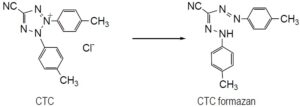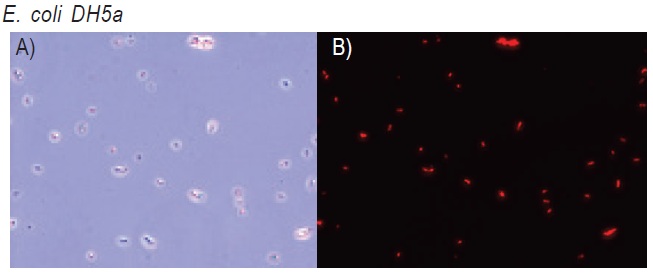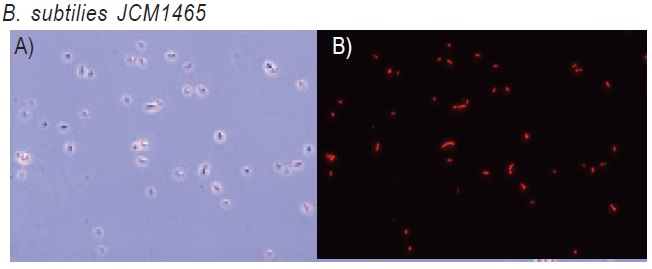CTC

Reductive Chromogenic Dye
-
Product codeC440 CTC
-
CAS No.90217-02-0
-
Chemical name5-Cyano-2,3-ditolyl-2H-tetrazolium chloride
-
MWC16H14ClN5=311.77
| Unit size | Price | Item Code |
|---|---|---|
| 100 mg | C440-10 |
Product Description
CTC can be used in various ways to detect bacteria, depending on the objective. Detection methods include the agar plate cultivation method, which involves counting colonies that arise from bacteria cultivation; staining bacteria using the fluorescent stain method; testing for bacteria that has potential for growth using the DVC method; and detecting particular bacteria using the FISH method-DNA amplification method. CTC is reduced to CTC formazan (CTF) by electron transfer through respiratory activity and builds up as fluorescent sedimentation inside a cell that has become insoluble in water. CTC itself is water-soluble and non-fluorescent in aqueous solution; CTF, however, is not fluorescent in fluids with low viscosity. However, in fluids with high viscosity and in a solid state, it gives off a red fluorescence. It is possible to search for cells with respiratory activity after incubating CTC with reagent, by counting under a fluorescent microscope or analyzing by flow cytometry. By using with nucleic acid staining reagent to count the total cell population and the number of living cells, or using with the FISH method to selectively count a particular viable cell type, it is possible to collect a higher level of data. Since the existence of VNC (viable but non-culturable) bacteria (has become evident, the demand for a rapid detection method of microorganisms is on the rise and is expected to become a technique in sanitation testing.
Chemical Structure

Technical info

E. coli staining Condition
E. coli culture was stained with 5 mg/ml CTC for 4 hours at 37ºC.
A) Phase-contrast microscope
B) fluorescent microscope (485 nm, 510 nm filters)

B. subtiles staining Condition
B. subtilis culture was stained with 5 mg/ml CTC for 4 hours at 37ºC.
A) Phase-contrast microscope
B) fluorescent microscope (485 nm, 510 nm filters)
References
1) A. W. Coleman, "Enhanced Detection of Bacteria in Natural Environments by Fluorochrome Staining of DNA", Limnol. Oceanogr., 1980, 25, 948.
2) E. Severin, J. Stellmach and H.-M. Nachtigal, "Fluorimetric Assay of Redox Activity in Cells", Anal. Chim. Acta, 1985, 170, 341.
3) G. G. Rodriguez, D. Phipps, K. Ishiguro and H. F. Ridgway, "Use of a Fluorescent Redox Probe for Direct Visualization of Actively Respiring Bacteria", Appl. Environ. Microbiol., 1992, 58 (6), 1801.
4) G. Schaule, H. C. Flemming and H. F. Ridgway, "Use of 5-Cyano-2,3-ditolyl Tetrazolium Chloride for Quantifying Planktonic and Sessile Respiring Bacteria in Drinking Water", Appl. Environ. Microbiol., 1993, 59 (11), 3850.
5) R. A. Bovill, J. A. Shalloross and B. M. Markey, "Comparison of the Fluorescent Redox Dye 5-Cyano-2,3-ditolyltetrazolium Chloride with p-Iodonitrotetrazolium Violet to Detect Metabolic Activity in Heat-stressed Listeria monocytogenes Cells", J. Appl. Bacteriol., 1994, 77 (4), 353.
6) M. T. E. Suller and D. Lloyd, "Flow Cytometric Assesment of the Postantibiotic Effect of Methicillin on Staphylococcus aureus", Antimicrob. Agents Chemother., 1998, 42 (5), 1195.
7) M. Kawai, N. Yamaguchi and M. Nasu "Rapid Enumeration of Physiologically Active Bacteria in Purified Water Used in the Pharmaceutical Manufacuturing Process", J. Appl. Microbiol., 1999, 86, 496.
8) N. Yamaguchi, M. Sasada, M. Yamanaka and M. Nasu, "Rapid Detection of Respiring Escherichia coli O157:H7 in Apple Juice, Milk, and Ground Beef by Flow Cytometry", Cytometry , 2003, 54A, 27.
9) A. Kitaguchi, N. Yamaguchi and M. Nasu, "Enumeration of Respiring Pseudomonas spp. in Milk within 6 Hours by Fluorescence In Situ Hybridization Following Formazan Reduction", Appl. Environ. Microbiol., 2005, 71(5), 2748.
Handling and storage condition
| Appearance: | White to slightly orange crystalline powder |
|---|---|
| Purity (HPLC): | ≧ 95.0 % |
| Solubility in water: | To pass test (almost clear, colorless or slightly yellow) |
| Molar absorptivity: | ≧ 7,500 (around 300 nm) |
| Sensitivity: | To pass test |
| IR spectrum: | Authentic |
| 0-5°C, Protect from light |









